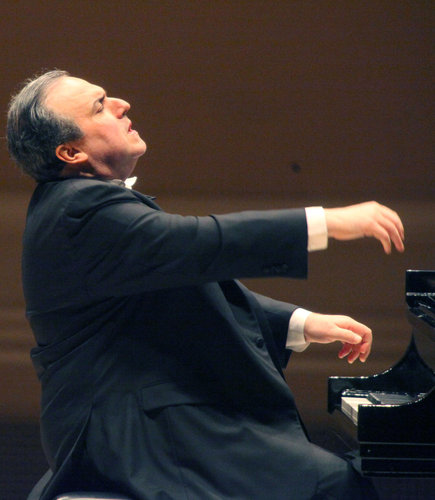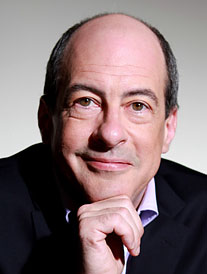Bronfman displays grace and bravura with the New World Symphony

Yefim Bronfman performed Bartok’s Piano Concerto No. 2 Saturday night at the Arsht Center in Miami.
From Yefim Bronfman’s Russian birth, large physical presence, and massive technique, you might expect a pianist who specializes in floor-shaking performances of Rachmaninoff and Tchaikovsky. And while he is capable of that, what was most impressive about his performance Saturday in Miami was the grace, intensity and control of his playing.
Bronfman appeared at the Arsht Center with the New World Symphony and guest conductor Robert Spano in Bartók’s Piano Concerto No. 2. One of the most difficult works in the repertoire, the concerto is a virtuoso display piece, 20th century style, in which the keyboard gymnastics come with gritty harmonies, angular melodies and brittle orchestral passages.
Bronfman’s performance seemed effortless in Bartók’s jangling, crashing fusillade of rapid-fire octaves, chords and runs, but without the detachment that can come with his level of mastery. He brought to the first movement a more lyrical touch than the percussive, almost frantic approach taken by many pianists, drawing out the folk melodies from which the composer obtained much of his musical material.
But Bronfman didn’t stint on the virtuoso elements, and a pulse of nervous energy ran through his playing, as in the blazingly quick notes that follow the cadenza. Under the baton of Spano, music director of the Atlanta Symphony Orchestra, the New World musicians gave a precise performance, with particularly fine playing by the brass in those bold, choir-like passages that Bartók writes for their instruments.
The soft string passage that opens the second movement was pretty much obliterated by a festival of coughing from the audience, showing the hazards of programming anything with extended quiet passages in the middle of flu season. Bronfman built a sense of great tension and foreboding in the movement, particularly in a passage punctuated by solemn timpani rolls. The last movement was a hard-driving release of tension, with Bronfman dashing through the virtuoso passages with gusto. Any pianist who performs Bartok’s Second has put in a full evening’s work, but Bronfman obliged the applause with an encore, Liszt’s Grandes Études de Paganini No. 2, an arrangement of one of Paganini’s violin caprices, performed with a sure, light touch.

Robert Spano
The concert opened with Tchaikovsky’s Francesca da Rimini, a rarely heard tone poem inspired by Dante’s portrayal of a noblewoman and her illicit lover in hell. The performance seemed underpowered, particularly in the first few minutes, a musical depiction of hell, where the wild, swirling music came off as more trudging than diabolical. But the love theme in the violins and winds was full of restlessness and yearning, and the performance gained drive and power as it drove to its dramatic, grim ending.
The concert concluded with Beethoven’s Symphony No. 7, performed in a straightforward manner with very tight, clean playing by the musicians. Winds performed particularly well in the first movement, playing the opening theme with deftness and style. The Allegretto can come off as heavy and plodding, yet under Spano’s baton, it was pulsing and urgent, with the conductor’s tight control over dynamics and tempo allowing the music to progress with the inevitability that seems built into much of Beethoven’s music. Spano led a buoyant performance of the final movement, with transparent textures and long lines that emphasized its dancelike poise and grace.
Posted in Performances
Leave a Comment
Sun Jan 6, 2013
at 1:59 pm
No Comments




